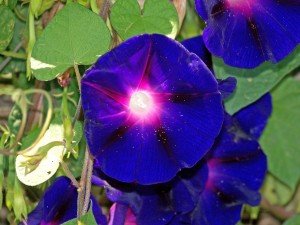Right now morning glories are working their way through the garden, climbing the trellising by the back porch, creeping along the ground in front of the privet hedge and insinuating themselves into the plantings between the sidewalk and the street. In short, they are everywhere. The reason for this is that ‘Grandpa Ott’s’, the variety that I planted years ago at the base of the trellising has self-seeded. A number of those seeds found their way into compost that I mixed with store-bought mulch and used all over the garden. The seeds apparently had a one hundred and ten percent germination rate and now are blossoming en masse.
There are worse things in life than too many morning glories.
Morning glories are something of a marvel. The flower petals—five apiece–emerge from twisted buds, unfurling into trumpet-shaped blossoms that open in full glory in the morning and close by the end of the day. The colors are beautiful—shades of white, true blue, purple, red and yellow, with some bi-colors—but it would be foolish to use them as cut flowers. The snip of the scissors is the flowers’ death knell and they generally fold their petals and die as you arrange them. It is much better to acknowledge the brevity of their lives and leave them on the vine.
The Latin name “ipomoea” comes from the Greek word “ips,” meaning “worms.” This almost certainly refers to the curling vines that will grasp onto just about anything in their path. These vining ways also mark them as members of the Convolvulaceae or bindweed family. Morning glory’s relative, Convolvulus arvensis, the common field bindweed, with its pretty white or pink flowers, is a bane of agricultural existence.
The annual morning glories now creeping over, under and around my property are cultivars of either Ipomoea purpurea, native to tropical parts of the Americas, or Ipomoea tricolor, native to similar tropical areas. Several sources mention that the seeds of the tricolor species have been used since at least the time of the Aztec empire for medicinal and hallucinogenic purposes. I presume morning glory seeds have long since been supplanted by substances that are more effective for one purpose or the other. They should be considered poisonous and kept away from unsupervised children and pets.
The variety that started my morning glory explosion, ‘Grandpa Ott’s’ is part of the tricolor species. It bears rich purple flowers and has a unique claim to fame. Handed down to Iowa gardener Diane Ott Whealy, the seeds inspired Ms. Whealy and her then-husband Kent to launch a quest for heirloom ornamental and edible seeds. Their research and outreach efforts culminated in the establishment of the Seed Savers’ Exchange in Decorah, Iowa in 1975. The Exchange, in turn, helped to fuel the heirloom gardening craze and its offspring, the garden-to-table/sustainable food movement.
Morning glories are easy to grow from seed and can be planted directly in the ground after all danger of frost is past. To speed germination, nick the large seeds with a nail file before planting. The vines will sprout in the spring and begin climbing, but will take off at mid summer and bloom until hard frost in the fall. The plants require sun, reasonable moisture and not much else. They are so determined that it’s likely if you stand still long enough in the proximity of a morning glory vine, it will begin clambering up your leg.
The range of available varieties is large and vendors offer both single and mixed variety seed packages. I like the time-tested favorite, ‘Heavenly Blue’, a tricolor variety that dates back to the 1930’s. The bright blue blossoms are as inspiring in the current recession as they were back in the Great Depression. Two striped cultivars, ‘Venice Blue’ and ‘Venice Pink’ create wonderful swirling patterns on trellises and other supports. I also covet ‘Glacier Star’, with palest blue flowers accented with a deeper blue “star” in the center.
For those with less space or container gardens, ‘Blue Ensign’, another tricolor variety is just right. Often described as a “dwarf” cultivar, it has white-throated, dark blue flowers and a mounding habit. When grown in a container, it will form a six inch-tall mound and eventually cascade attractively over the side.
Morning glory seeds are available at most garden centers and big-box stores. Right now, in late July, some packages may be left. If you live in USDA Zone 6 or above, buy now, nick the seeds, plant right away, and water regularly. You will probably have a good chance of blooms in the fall.

If you are thinking ahead to next spring, or making notes in a garden diary, take a look at the varieties offered by Select Seeds, 180 Stickney Hill Rd, Union, CT 06076-4617, (800)-684-0395, www.selectseeds.com. Free catalog.
